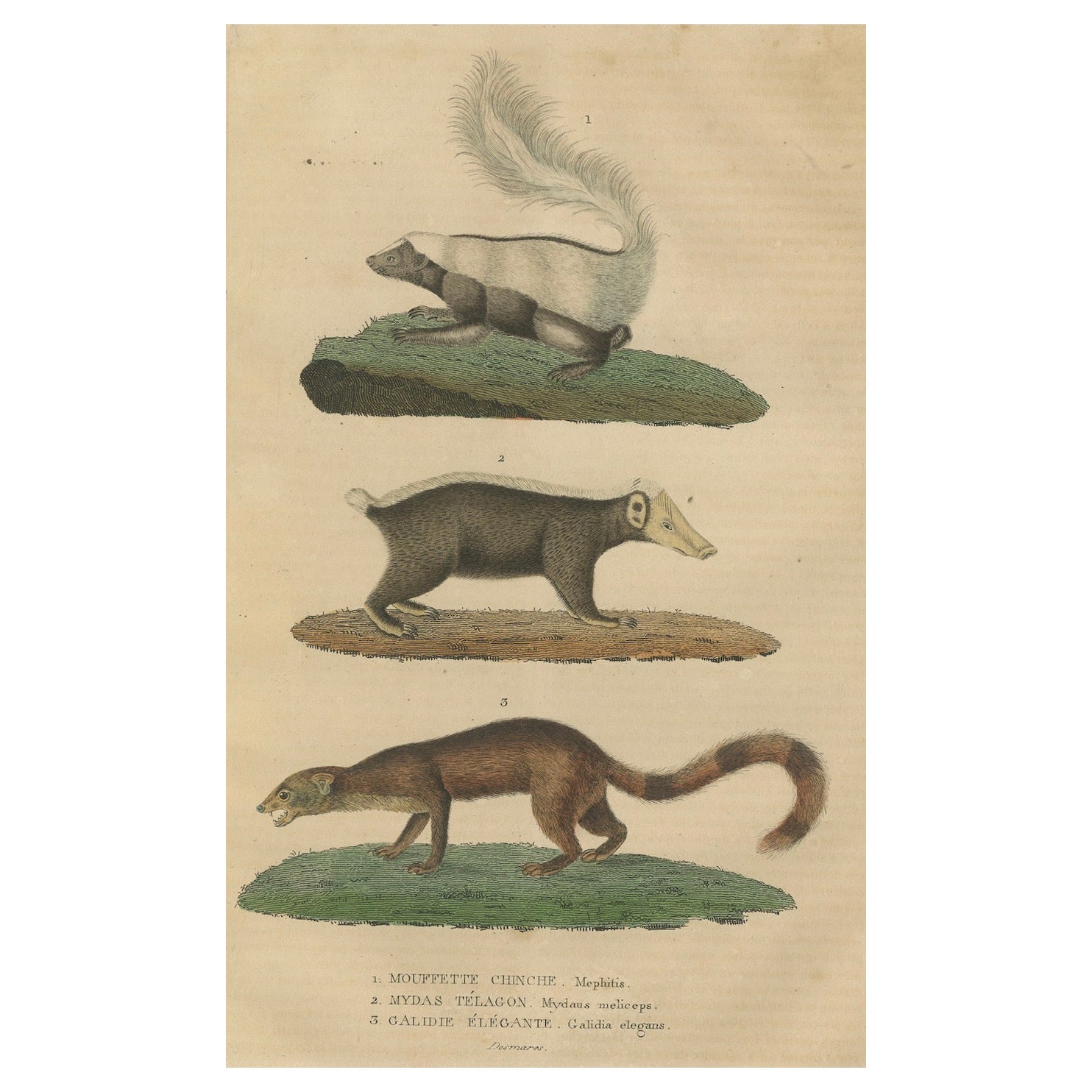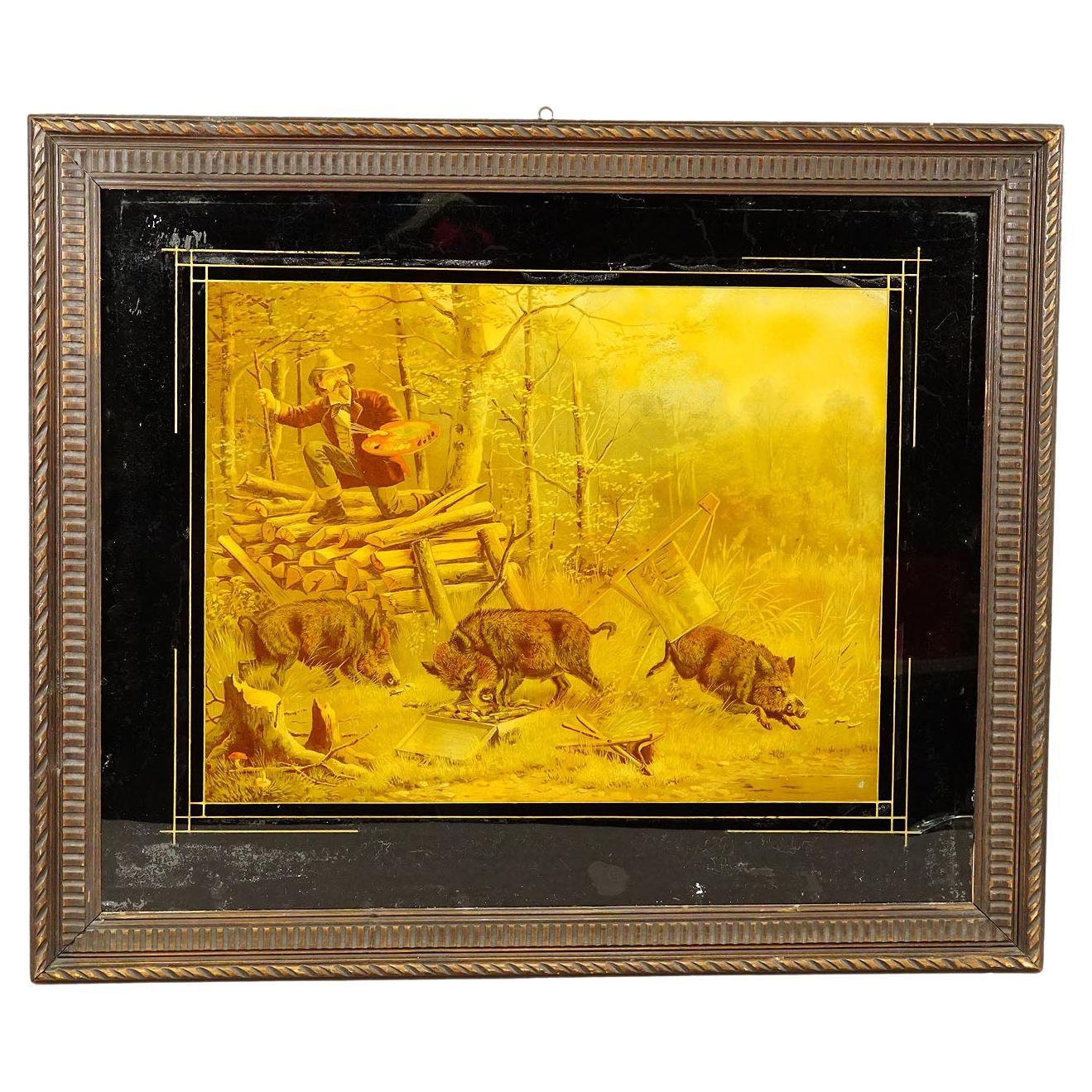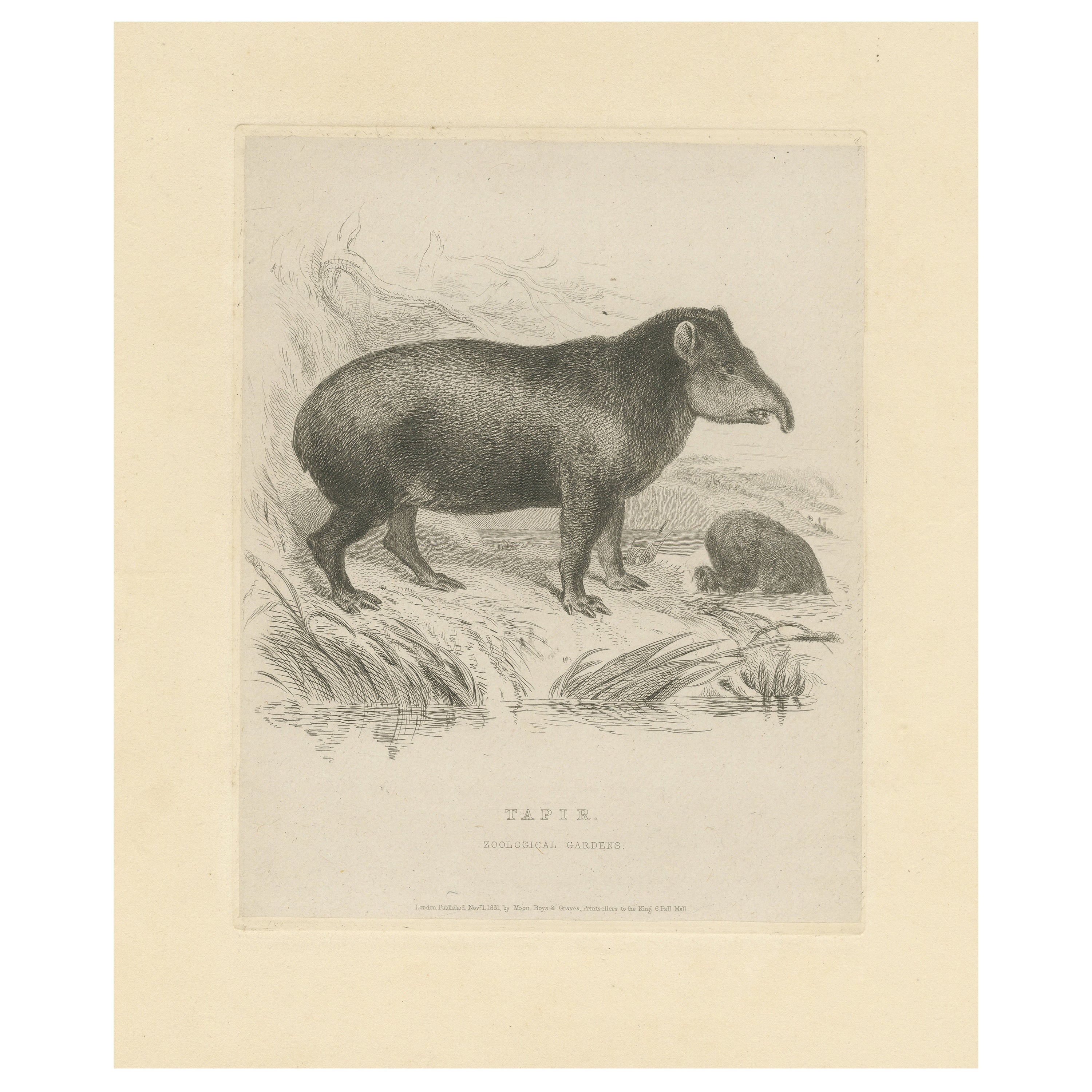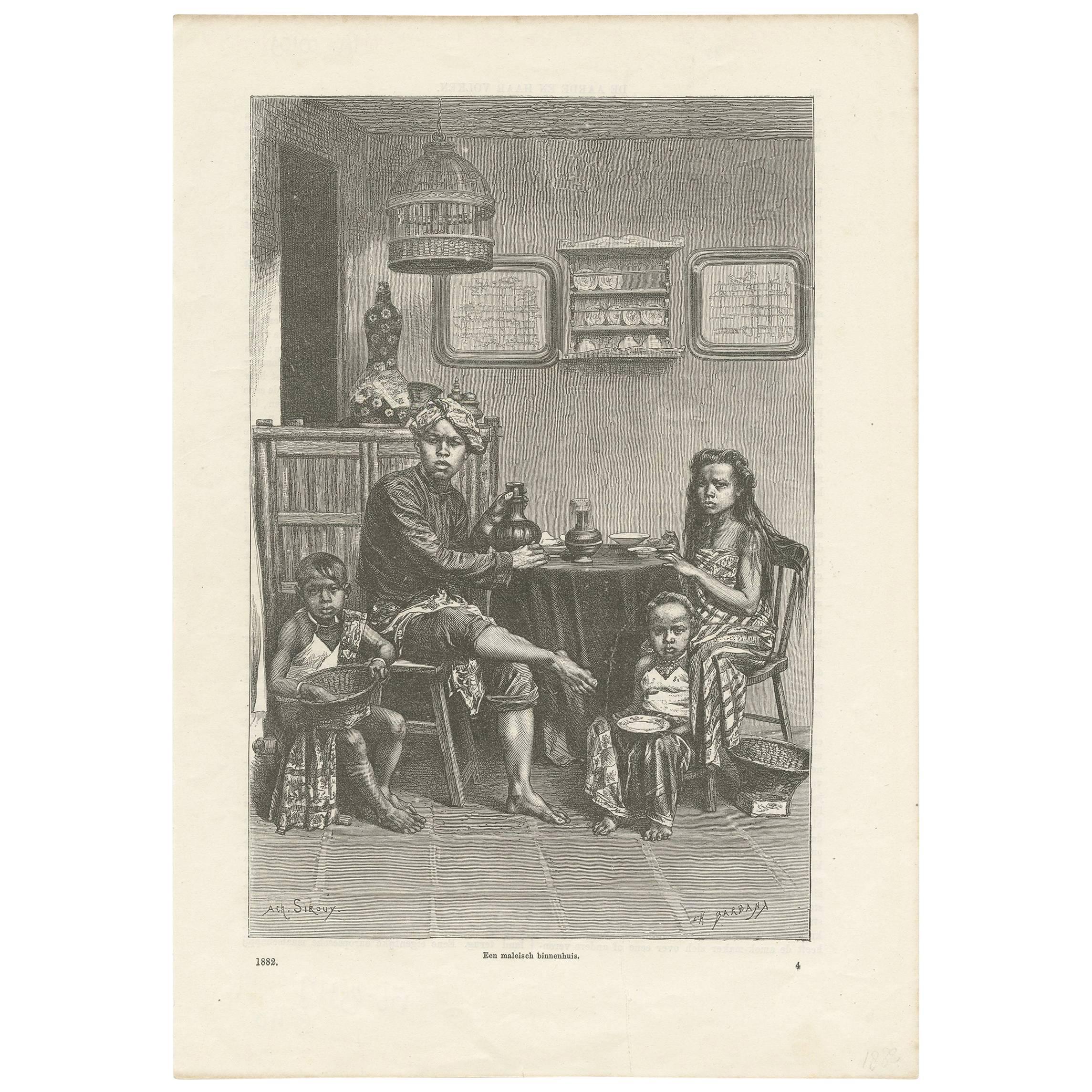Items Similar to Terrestrial Mammals: Wild Boar, Indian Rhinoceros, and Malayan Tapir, 1845
Want more images or videos?
Request additional images or videos from the seller
1 of 6
Terrestrial Mammals: Wild Boar, Indian Rhinoceros, and Malayan Tapir, 1845
About the Item
An original antique hand-colored engraving featuring three different species of animals, each labeled in both Latin and French:
1. **Sus scrofa** - Commonly known as the wild boar. This illustration shows a dark-colored boar with sharp tusks and a somewhat aggressive stance, indicative of the species' reputation for being fierce and territorial.
2. **Rhinoceros indicus** - Known as the Indian rhinoceros. The animal is depicted with a single black horn on its snout and thick, folded skin that looks like armor plating, which is characteristic of this species. It's shown in profile, giving a clear view of its body shape and size.
3. **Tapirus indicus** - This is the Malayan tapir, identifiable by its distinctive coloration with a black front and back and a white or light-colored 'saddle' that extends from its shoulders to the rear. The tapir has a short, prehensile trunk, and the illustration captures this unique feature.
The print is detailed and colored in the 19th century when such illustrations were common in scientific works. The animals are depicted in their natural habitats or settings that resemble it, which adds educational value to the illustration. The precise lines and the careful coloring suggest that the print was made with the intent to accurately educate about these species. They were part of a larger collection of animal illustrations used for academic or encyclopedic purposes.
It is an illustration from the 'Dictionnaire Classique des Sciences Naturelles' by Pierre Auguste Joseph Drapiez, which was published in 1845. This work is part of the tradition of 19th-century natural history publications that aimed to document and describe the natural world in detail. The illustrations in such works were both scientifically informative and artistically rendered, often by skilled artists who specialized in natural history subjects.
Each animal in the illustration is drawn with attention to anatomical detail and is placed within a naturalistic setting, which reflects the scientific and educational intentions of the work. The labels provide the scientific Latin name, which was and still is the universal language of taxonomy, as well as the common French name, indicating the animal's common identification in the region where the book was published.
This particular print would have served as an important reference for scholars, naturalists, and enthusiasts of natural history in the mid-19th century, offering a visual complement to the written descriptions found within the text of the 'Dictionnaire'. The fact that these illustrations are still appreciated today speaks to their quality and the enduring interest in the natural world.
- Dimensions:Height: 10.44 in (26.5 cm)Width: 6.7 in (17 cm)Depth: 0 in (0.02 mm)
- Materials and Techniques:Paper,Engraved
- Period:
- Date of Manufacture:1845
- Condition:Very good. Strong paper. Edge on the right side roughly cut short. Please study the image carefully.
- Seller Location:Langweer, NL
- Reference Number:
About the Seller
5.0
Platinum Seller
These expertly vetted sellers are 1stDibs' most experienced sellers and are rated highest by our customers.
Established in 2009
1stDibs seller since 2017
1,916 sales on 1stDibs
Typical response time: <1 hour
- ShippingRetrieving quote...Ships From: Langweer, Netherlands
- Return PolicyA return for this item may be initiated within 14 days of delivery.
More From This SellerView All
- Original Antique Print of a Wild Boar and a LionBy Samuel HowittLocated in Langweer, NLAntique print titled 'Wild Boar and Lion'. Old print of a wild boar and a lion. This print originates from a series depicting fables by Samuel Howitt. Samuel Howitt was an English painter...Category
Antique Early 19th Century Prints
MaterialsPaper
- Diverse Mammals Engraved and Hand-Colored: Skunk, Stink Badger, and Canid, 1845Located in Langweer, NLThis original antique engraving displays three different mammalian species: 1. **Mephitis mephitis** - Commonly known as the striped skunk. Characterized by its prominent striped fu...Category
Antique 1840s Prints
MaterialsPaper
- Antique Animal Print of a TapirLocated in Langweer, NLAntique print titled 'Tapir'. Original old print of a tapir. This print originates from the series 'Characteristic sketches of animals, principally from the Zoological Gardens, Regen...Category
Antique Mid-19th Century Prints
MaterialsPaper
- Antique Print of a Malayan Family, 1882Located in Langweer, NLAntique print titled 'Een Maleisch binnenhuis'. This print orginates from 'De Aarde en haar Volken' by H.D. Tjeenk Willink en Zoon, Haarlem, 1882.Category
Antique Late 19th Century Prints
MaterialsPaper
- Antique Print of an Elephant, Tapir and Other Animals, C.1855Located in Langweer, NLAntique print of various animals including a tapir, pig, boar, elephant, hippo and others. Most likely originates from and edition of 'Iconographic encyclopaedia of science' by G. He...Category
Antique 19th Century Prints
MaterialsPaper
- Old Original Hand-Colored Print of a Tapir and an Anteater, ca.1860Located in Langweer, NLAntique print titled 'Le Tapir - Le Tamanoir'. Old print of a tapir and an anteater. This print originates from 'Types du regne animal; Buffon en estampes', a book with 48 hand-colored plates of animals. Artists and Engravers: Édouard Traviès...Category
Antique 1860s Prints
MaterialsPaper
You May Also Like
- Antique Print with Humoristic Scene Featuring Wild Boars and a PainterLocated in Berghuelen, DEAntique Print with Humoristic Scene featuring Wild Boars and a Painter A colorful antique oil print depicting a humoristic scene in the Black Fore...Category
Antique Late 19th Century German Black Forest Prints
MaterialsGlass, Wood
- 17th Century "Diana's Deer and Boar Hunt" Etching by Antonio TempestaBy Antonio TempestaLocated in Cagliari, ITA fine mythological etching by the great Italian engraver Antonio Tempesta (Florence, 1555 – Rome, 5 August 1630) printed by François L'Anglois or Langlois (12 May 1589 (baptised) – 13 January 1647),also called F. L. D. Ciartres (" Francois Langlois from Chartres"). Beautiful sheet , very sharp . The dimensions below are inclusive of the frame, the print without the frame measures 27x19 cm Antonio Tempesta, also called il Tempestino (1555 – 5 August 1630), was an Italian painter and engraver, whose art acted as a point of connection between Baroque Rome and the culture of Antwerp. Much of his work depicts major battles and historical figures. He was born and trained in Florence and painted in a variety of styles, influenced to some degree by "Counter-Maniera" or Counter-Mannerism. He enrolled in the Florentine Accademia delle Arti del Disegno in 1576. He was a pupil of Santi di Tito, then of the Flemish painter Joannes Stradanus. He was part of the large team of artists working under Giorgio Vasari on the interior decoration of the Palazzo Vecchio in Florence. His favourite subjects were battles, cavalcades, and processions. He relocated to Rome, where he associated with artists from the Habsburg Netherlands, which may have led to his facility with landscape painting. Among his followers was Marzio di Colantonio. Tempesta and the Flemish painter Matthijs Bril were commissioned by Pope Gregory XIII to paint wide panoramas of the Procession to Transfer the Relics of St. Gregory of Nazianzus (1572) for the loggias on the third floor of the Vatican Palace. He completed frescoes in the Palazzina Gambara at the Villa Lante in Bagnaia (1578-1609). From 1579–83, Tempesta participated in the decoration of the Villa Farnese in Caprarola, notably of this villa's Scala Regia. He is also known to have collaborated on frescoes in the Villa d'Este at Tivoli and the Palazzina Gamara at Villa Lante, Bagnaia. He painted a series of turbulent and crowded battle scenes for the Medici. He also completed a series of engravings on outdoor courtly hunting scenes. Tempesta painted frescoes for the Palazzos Colonna, the Doria Pamphilj, and for the Marchese Giustiniani in his Roman palace, where Tempesta collaborated with Paul Bril, and at Bassano di Sutri. He painted a Massacre of the Innocents for the church of Santo Stefano Rotondo in Rome. Tempesta is now best known as a printmaker in etching and engraving. He also left numerous etchings, among them: Plates from the Old Testament; twenty-four plates from the Life of St. Anthony; a set of 150 prints from Ovid’s Metamorphoses; 13 plates on The Labours of Hercules and four plates on respectively The ages of man; The entry of Alexander into Babylon; Diana and Actaon, and The crucifixion (1612). In 1612 he engraved a series of plates under the title "Batavorum cum Romanis Bellum" after designs of the Netherlandish artist Otto van Veen, also known as Vaenius (1556-1629) and court painter to Alessandro Farnese. Van Veen was influenced by the Italian mannerists but had developed his own style anticipating the Flemish baroque of his pupil Peter Paul Rubens. The series consists of 36 numbered engraved plates and illustrates the armed struggle between the ancient Dutch tribes and their Roman oppressors as narrated in Tacitus' Histories. Each plate bears at the bottom an engraved legend in Flemish and in Latin while a detailed explanation is printed on the otherwise blank verso. Plate I, signed 'Ant.Tempesta f. Anno 1611', shows 'Roma' and 'Batavia' in battle dress with respective scenic backgrounds, symbolizing the two nations. Fifteen other plates bear Tempesta's monogram. The plates depict heroic events, sieges, and battle scenes. This historicist work was very popular in its time. Tempesta also drew many designs for tapestries. François L’Anglois or Langlois (12 May 1589 (baptised) – 13 January 1647), also called F. L. D. Ciartres ("François Langlois from Chartres"), was a French print publisher, print seller, engraver, bookseller, art dealer, and painter. He is widely considered to have been the first important print publisher in France and to have contributed significantly to spreading awareness of contemporary artists' work throughout Europe. François L’Anglois was born in Chartres and baptised there on 12 May 1589. He visited Italy on several occasions: Rome in 1613 and 1614 and Genoa, Florence, and Rome again in 1621. On these trips he met Anthony van Dyck and Claude Vignon, who both painted his portrait. He also became acquainted with the engravers Stefano della Bella and François Collignon. It was probably around this time that he acquired the nickname of Chartres (Ciartres in Italian). In 1624–1625 he was associated with Vignon as an art dealer (paintings) and acted as a print collector for Thomas Howard, 14th Earl of Arundel, and Charles I of England...Category
Antique 17th Century French Baroque Prints
MaterialsPaper
- Large Original Antique Natural History Print, Rhinoceros, circa 1835Located in St Annes, LancashireGreat image of an Indian and a lesser two horn rhino Unframed. It gives you the option of perhaps making a set up using your own choice of frames. Lithograph after Cpt. brown with ...Category
Antique 1830s English Folk Art Prints
MaterialsPaper
- François-xavier Lalanne '1927-2008' Rhinocéros 'Also Known as Rhinocrétaire'By François-Xavier LalanneLocated in Saint ouen, FRFrançois-Xavier Lalanne (1927-2008) Rhinocéros (also known as Rhinocrétaire) Very rare poster for the gallery Alexandre Iolas, printed on golden paper, 1970’s, very good conditio...Category
Vintage 1970s Prints
MaterialsPaper
- Anatomical Print on Paper, Depicting Marine Mammals, P. Dybdahls, Norway, 1890Located in Milan, ITA chromolithographic print on paper by P. Dybdahls, depicting an anatomical table (Pl. 21) of marine mammals. Fir wood frame, walnut briar ven...Category
Antique Late 19th Century Norwegian Prints
MaterialsWalnut, Paper
- 1827 Polar Bear, Mammal, Oudart, Large Hand Coloured Stone Lithograph, RareLocated in Norwich, GBOur Blanc de la Mer Glaciale Tres remarquable par sa tete allongee, et sa blancher…. Dimensions: Height: 10.83 in (27.5 cm) Width: 14.57 in (37 cm) Extremely rare. Is...Category
Antique 1820s French Prints
MaterialsPaper





